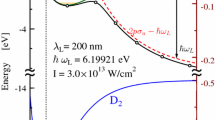Abstract
A laser ion-molecule reaction interaction through both polarizability and dipole moment contribution leads to variation in the intersection point in potential energy surface crossings along the reaction path; the polarizability is maximum and the dipole changes its sign at s = 4 a.u., defining a virtual transition state. Using the gauge representation (electric field gauge) for a wave length λ = 20.6 μm, intensity I = 5×1012 W/cm2, I = 1×1013 W/cm2, I = 3×1013 W/cm2, we show here that we can create a laser-induced potential energy surface crossing along the reaction path (s = 7-8 a.u.). We illustrate such effects for the Li H + CH +3 ↔ Li+ + CH4 reaction which takes the form of inverted Morse (without a barrier) using ab initio methods for calculating the reaction path and electric properties of the ion-molecule reaction.
Similar content being viewed by others
References
A. D. Bandrauk and H. Kono, in: Advances in Multiphoton Processes, Spectroscopy, S. H. Lin (ed.), vol. 15, World Scientific, Singapore (2003), p. 150.
M. Shapiro and P. Brumer, Principles of the Quantum Control of Molecular Processes, Wiley-Interscience, N. Y. (2003).
G. Paulus et al., Phys. Rev. Lett., 91, 253004 (2003).
V. S. Yakovlev et al., Appl. Phys., B76, 329 (2003).
S. Chelkowski and A. D. Bandrauk, Phys. Rev., A65, 061802 (2002).
A. E. Orel and W. H. Miller, Chem. Phys. Lett., 57, 362 (1978) J. Chem. Phys., 73, 241 (1980).
A. E. Orel and W. H. Miller, J. Chem. Phys., 70, 4393 (1979).
T. Brabec and F. Krausz, Rev. Mod. Phys., 72, 545 (2000).
A. D. Bandrauk and M. S. Child, Mol. Phys., 19, 95 (1970).
D. G. Truhlar and A. D. Isaacson, J. Chem. Phys., 77, 3516 (1982).
M. Tag El-Din Kamal, S. El-Wallid Sedik, and H. Talaat, Z. Phys. Chem., 222, 1693 (2008).
V. Ramatmurthy et al., Chem. Commun., 2003 (1987).
S. Chelkowski and A. D. Bandrauk, Opt. Lett., 29, 13 (2004).
M. C. Heaven, in: Chemical Dynamics in Extreme Environments, R. A. Dressler (ed.), World Scientific, Singapore (2000).
L. V. Keldysh, Sov. Phys., J. Exp. Theor. Phys., 20, 1307 (1965).
P. B. Corkum, N. H. Burnett, and F. Brunel, Phys. Rev. Lett., 62, 1259 (1989).
L. D. Landau and E. M. Lifshitz, Quantum Mechanics, Pergamon Press, N. Y. (1965).
C. Dion, A. Keller, O. Atabek, and A. D. Bandrauk, Phys. Rev., A59, 1382 (1999).
H. Stapelfeldt and T. Seideman, Rev. Mod. Phys., 75, 543 (2003).
L. Pan, K. T. Taylor, and C. W. Clark, J. Opt. Soc. Am., B7, 509 (1990).
A. D. Bandrauk and S. Chelkowski, Phys. Rev. Lett., 84, 3562 (2000).
J. Levesque, S. Chelkowski, and A. D. Bandrauk, J. Phys. Chem., 107, 3457 (2003).
C. Moller and M. S. Plesset, Phys. Rev., 46, 618 (1934).
M. J. Frisch et al., Gaussian 2003, Gaussian Inc., Pittsburgh PA (2003).
K. Fukui, J. Phys. Chem., 74, 4161 (1970).
K. Fukui, Acc. Chem. Res., 14, 363 (1981).
C. Gonzalez and H. B. Schlegel, J. Chem. Phys., 90, 2154 (1989).
C. Gonzalez and H. B. Schlegel, J. Phys. Chem., 94, 5523 (1990).
H. Talaat, A. H. Moussa, M. Shalaby, S. El-Wallid Sedik, and M. Tag El-Din Kamal, Russ. J. Phys. Chem., 87, 454 (2013).
Author information
Authors and Affiliations
Corresponding author
Additional information
Original Russian Text © 2018 M. Tag El-Din Kamal, El-Wallid S. Sedik, H. Talaat.
The text was submitted by the authors in English. Zhurnal Strukturnoi Khimii, Vol. 59, No. 1, pp. 28–35, January–February, 2018.
Rights and permissions
About this article
Cite this article
Tag El-Din Kamal, M., Sedik, EW.S. & Talaat, H. Variation of the Intersection Point of the Potential Surface Crossing Induced by the Laser Phase Along the Reaction Path in Ion-Molecule Reactions: Application To Li+ + CH4. J Struct Chem 59, 20–27 (2018). https://doi.org/10.1134/S0022476618010043
Received:
Revised:
Published:
Issue Date:
DOI: https://doi.org/10.1134/S0022476618010043




